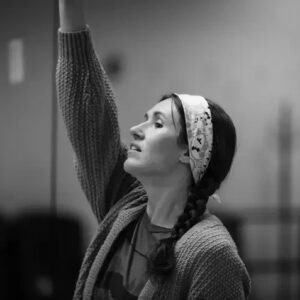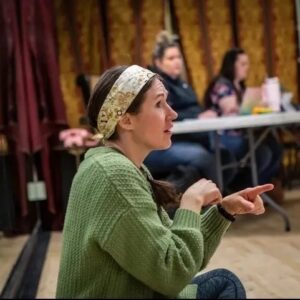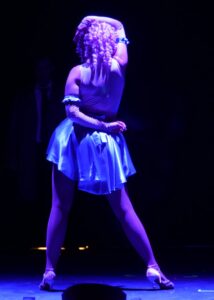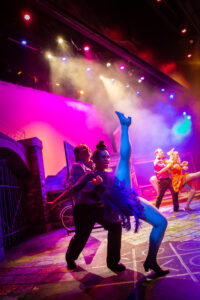This post is the second in a series on what I’m looking for in the casting process. I currently work in local community and semi-professional theatre and teach theatre at a high school.

I Love Dance Callbacks
I love watching the learning part of a dance callback. I think it’s one of the most revealing parts of the audition process. If you notice in the infographic below that there are elements in the dance callback that I’ve called dance skills that are soft skills essential for an actor or singer too, then you are correct. I’ve just found that it is most convenient and easy for me to get a handle on the attitude and work ethic of a performer that I’ve never worked with during the dance callback, provided the dance callback includes a section on learning a sequence from scratch. It’s where you see if an approaching dancer has pleasant grit or if a masterful dancer helps others around them and isn’t coasting on ability. It’s also the best place, in my current opinion, to get a sense of the vibe of a person, a pair, a small group, and a big group.
Additionally, dance callbacks can be amazingly fun! You tend to get a bigger group of auditioners together in the dance callback than you do pairing them up to read or singing them by character. All those people doing something physical at the same time and in the same space can be community building. Plus, you’re playing music–good music if you like the show you’re working on. If the people in charge create a warm and encouraging atmosphere, you can get people genuinely smiling in between audition attempts. It’s the place in auditioning where I see more people feel a sense of achievement with less undercurrent of competition.

I also think it’s one of the places in the audition process where I can give every person who makes the callback a gift. I can’t give everyone the gift of casting them the way they want, but I can give them the chance to have fun, the opportunity to exercise, and, hopefully, a little practice or tip that helps them leave a better dancer than they arrived. I know it can be efficient to have people learn a dance routine through video tutorials and then submit a video back, but you can pry the live-teaching, in-person dance callback from my cold, dead hands.

Accuracy
Maybe you look at the infographic and wonder, where is the need for accuracy? Yes, I’m hoping that every person in the dance callback can physically replicate the basic definition of the moves I’ve set in sequence. It’s so foundational that it’s a must, like matching pitch is in singing. And like matching pitch, some people do it better in a group than they do it alone. Even though accuracy is essential, I don’t have a separate category for it. It either undermines or strengthens all the other categories. You can’t flow between or snap from one movement to the next in Sequence like I’m hoping to see if you get the sequence or movements wrong. If you’re struggling with accuracy, Specificity suffers. You may be capable of Expression in spite of inaccuracies, but they likely won’t be the expressions I’m going for. So, let’s look at the remaining four skills: work ethic, ensemble, dynamic, and attitude.

If a dancer is struggling with accuracy but I see good-hearted investment in rehearsing the callback, I want to cast that person. Depending on the demands of the show and the other variables, maybe I can’t, but I want to. Perhaps this is the educator in me.
In my opinion, the skills I’ve described under Ensemble and Dynamic are two of the hardest things to get a performer to do by giving notes if they haven’t already unlocked these abilities. When I see them in a callback, even if I’m seeing some inaccuracy, I’m thrilled. I think, “Rehearsals will give you more time than this, you’ll get there because you see where I’m headed. You use dancing to act.” Some accurate dancers never get there with Ensemble or Dynamic, or only can get there in the high-adrenaline performances of opening nights or having someone they care about in the audience. Maybe I’m just more confident in my ability to coach accuracy than I am to infuse acting into someone who thinks accuracy and technical proficiency is all I’m looking for.

I’d Like to Improve as a Dancer
Dance lessons. Can’t afford the money or the schedule? YouTube. Some moves, while intellectually understood, can’t be physically mastered in the course of a rehearsal process. They require a greater degree of conditioning or flexibility. Dance is sport as art and a real dancer applies all the training and consistency of the athlete. If performances are games, and rehearsals are practices, then there must be training and conditioning for the dancer too, long before the audition process. Auditioning well is often considered a separate skill than performing. If you struggle to pick up a routine as quickly as a callback asks, you can train that skill too. Pick a different dance tutorial every day and condition your skill of learning a dance sequence quickly.


Then let go. Technique is great. Training is great. But dance within musical theatre should always be at the service of the story and the story is best served by fighting to communicate and get what you want. Shoot for the story. Aim to express. Don’t hold back for fear of judgment or embarrassment. That kind of lock on your vocal chords wouldn’t benefit your voice. That hindering of bold choice-making and lack of commitment wouldn’t benefit your acting. Trust the story and use your body to play.

